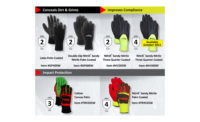Vinyl vs nitrile disposable gloves
Research shows different glove types can significantly contribute to the spread of hand/glove-transmitted pathogens in food.

Disposable gloves have been identified by the FDA as potential sources of cross-contamination, with scientific studies implicating contaminated gloves as contributory factors in more than 15% of foodservice foodborne outbreaks investigated.
Despite these figures, disposable gloves have been overlooked by the FDA Food Safety Modernization Act (FSMA) because the risk of contamination from disposable gloves is not seen as a great enough food safety threat to warrant further investigation.
However, research shows different glove types can significantly contribute to the spread of hand/glove-transmitted pathogens in food.
Many different types of disposable gloves are used for food processing and handling. But, each glove type has different surface and physico-chemical characteristics that can either increase or mitigate food safety risks. Differences within the same type of gloves also occur due to the quality of raw materials and standards of manufacturing, further affecting food safety.
Accumulating scientific evidence proves vinyl gloves, said to be the most common food handling glove in the United States, are a food safety risk. Here’s how vinyl gloves compare to nitrile disposable gloves.
Structure
Studies highlight the lack of cross-linking of the PVC polymer, and together with plasticizers, which weaken the vinyl glove structure, can produce micro-punctures within only a few hand flexes or food handling tasks. In some cases, vinyl gloves begin leaking as soon as they are donned.
Because of their chemical-resistant properties, superior strength and thin wall construction, nitrile gloves are increasingly being utilized in food processing and foodservice environments.
Failure rates
Studies have compared barrier integrity of new vinyl and nitrile gloves, with the gloves tested under conditions of activity. The gloves were subjected to water leak tests.
Up to 18,000 staphylococci have been shown to pass through a single glove hole during a 20-minute period, even though the hands had been scrubbed for 10 minutes prior to gloving. With more than 250 different foodborne diseases associated with food or drink, there is ample opportunity for leaky gloves to share responsibility for transmission.
Cross-contamination rates
Scientific evidence indicates vinyl disposable gloves (over other types) are more frequently responsible for cross-contamination events in food handling where glove type is identified. Recent research conducted by international food safety consultant Barry Michaels has shown vinyl (PVC) gloves were found to be up to three times more likely to spread bacteria than quality nitrile gloves tested, due to their physico-chemical characteristics.
Hydrophobicity vs. hydrophilicity
Generic brands of PVC (vinyl) gloves are more hydrophilic when compared to lower-stick nitrile gloves. This means food and human soil contaminants, associated microbial populations of spoilage species and potential pathogens are more easily picked up and spread over vinyl glove surfaces and anything they touch, when compared to nitrile gloves.
In another study, glove material and glove hydrophobicity were identified as the two most important factors influencing bacterial transfer. Nitrile gloves were associated with the lowest transfer rates.
Extensive research evidence shows that bacteria (mainly those related to food processing surfaces, such as Listeria monocytogenes) attach more to high-energy hydrophilic surfaces than to hydrophobic surfaces.
Worker and environmental health
Vinyl gloves have been banned for food handling in Japan, with many other countries and companies reducing or removing PVC, including vinyl gloves from their products. The reasons being their negative effect on human and environmental health.
Nitrile gloves—comparing different brands
Raw materials and manufacturing standards
Variability in nitrile gloves are influenced by the fillers, plasticizers and vulcanization accelerator(s), with considerable variability in nitrile gloves attributed to polymer formulations between glove types.
Pores and imperfections can be seen in poor quality nitrile gloves. New formulation nitrile gloves have smoother surfaces and are significantly superior. Cheaper raw materials not only weaken the product physically and chemically, but can also introduce toxic compounds, from known endocrine disruptors to potassium cyanide. While the former is common in vinyl plasticizers, the latter has occasionally been found in nitrile gloves.
Additionally, some of the sulphur-based accelerators standard nitrile gloves use as raw materials are now included in the California Prop. 65 list of chemicals known to the state of California to cause cancer.
Factory conditions
Research found an increased bacteria count on gloves from unopened glove boxes. One of the many common shortcuts in low-cost manufacture is the reduction of wash tank clean-out or water quality. This leads to a longer build-up of microbial and chemical loading, with glove user and food contact consequences. Studies have indicated environmental contaminants of up to 10,000 bacteria per glove and skin commensals ranging almost up to 1,000 CFU per glove.
Limited wash tank use also leads to chemical impurities on and inside gloves, causing chemical migration to food and irritants to users.
Examination grade vs. food grade
The AQL of a disposable glove is the “Acceptable Quality Level” and refers to a quality standard for measuring pinhole defects. The lower the AQL, the less defects gloves have. Examination-grade gloves have a required AQL of 2.5 or less (maximum of 2.5 defects acceptable per 100 gloves). In comparison, food-grade gloves have no attributed AQL, no acceptable minimum defects per box.
Summary
Science has shown vinyl gloves to be a poor food safety option, although not all nitrile gloves are created equal. Distributors often purchase from different glove manufacturers, with different chemical formulations, leading to inconsistent quality. A glove color may still look blue, but all else might be different. Sourcing from a reputable supplier working with a consistent manufacturer is essential for reliable food-safe nitrile glove quality and performance.
Looking for a reprint of this article?
From high-res PDFs to custom plaques, order your copy today!




